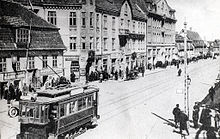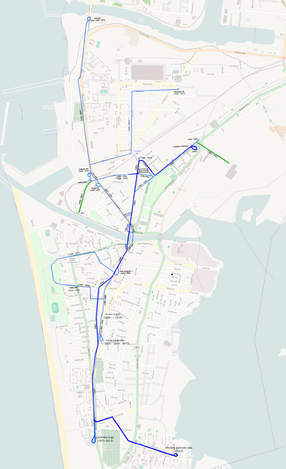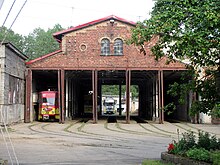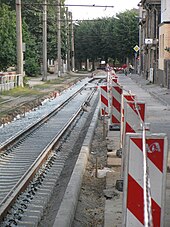Liepāja tram
| Liepāja tram | |
|---|---|
| Tatra KT4 railway No. 239 in Klaipēdas iela | |
| Basic information | |
| Country | Latvia |
| city | Liepāja |
| opening | September 26, 1899 |
| operator | SIA "Liepājas tramvajs" |
| Infrastructure | |
| Route length | 7.9 km |
| Gauge | 1000 mm ( meter gauge ) |
| Power system | 600 volt DC overhead line |
| Stops | 18th |
| business | |
| Lines | 1 |
| Clock in the peak hours | 7 min |
| Cruising speed | 17.05 km / h |
| vehicles | 16 Tatra KT4 |
| Development of the route network (dark blue: in operation) | |
The tramway in Liepāja has existed since 1899. The Latvian city of Liepāja has the oldest electric tram network in the Baltic States . Since 1972 there has only been a single tram line Metallurgie (Grobiņas iela) ↔ Central Cemetery (Vaiņodes iela) with a length of 6.9 km in Liepāja . The Liepāja tram is the only meter-gauge tram system in Latvia. Unlike the other Latvian trams ( Riga , Daugavpils ), the trolley booms use the tram Liepaja used since 1961 pantograph (pantograph). On May 29, 2013, a route extension from the central cemetery to the suburb of Ezerkrast 2 went into operation.
history

| Stops | |||||||||||||||||||||||||||||||||||||||||||||||||||||||||||||||||||||||||||||||||||||
|---|---|---|---|---|---|---|---|---|---|---|---|---|---|---|---|---|---|---|---|---|---|---|---|---|---|---|---|---|---|---|---|---|---|---|---|---|---|---|---|---|---|---|---|---|---|---|---|---|---|---|---|---|---|---|---|---|---|---|---|---|---|---|---|---|---|---|---|---|---|---|---|---|---|---|---|---|---|---|---|---|---|---|---|---|---|
|
|||||||||||||||||||||||||||||||||||||||||||||||||||||||||||||||||||||||||||||||||||||
On August 22, 1896, the Libau City Council decided to build an electric tram line. The Nuremberg-based Continental Society for Electrical Companies won the competition to build the tram . On December 14, 1896, the mayor Adolphi and the representative of the Nuremberg Continental Company Manashevich signed the contract, according to which the company got the right to operate the tram for 40 years. The city received the right to buy the tram system after 20 years. The total length of the two lines to be built was 10.42 km.
The test drives of the Libau tram began on September 14, 1899, and scheduled operation began on September 26, 1899. From October 14, 1899, two lines were operated: the white line to the military port ( Karosta ) and the green line to the train station. In November 1899, both lines were extended to Alt-Libau (Siena tirgus).
At the end of June 1941, the tram service in Liepāja was temporarily suspended because the advancing German troops bombed the city. Tram traffic was resumed in mid-July 1941. However, the section along Peldu iela (Peldu Street) was closed and the tracks were used to repair the other lines. In 1944 the overhead line of the tram network was dismantled by order of the German occupying forces, as they were interested in copper. As a result, tram operations had to be stopped a second time, but tram traffic could start again on November 7, 1945.
In 1950, construction began on a new line connecting the city center with the sugar factory on Ventspils iela. The railways on this route were given line number 3. However, this line was shut down again in 1953 due to a lack of economic efficiency.
In 1961 the pole-type pantographs were replaced by pantographs . Within one day, on December 17, 1961, the overhead line was adjusted so that on December 18, 1961 the trains could run with pantographs.
On June 23, 1972, the tram line was expanded from the old town via Klaipēdas iela (Klaipeda Street) to the Central Cemetery (Centrālie kapi), which significantly increased the route network. Lines 1 and 2 have been extended to the new terminal. The increase in vehicle kilometers resulted in a shortage of cars, which is why operations on line 4 to the military port (Karosta) were stopped on October 6, 1972.
On March 15, 1976, the ticket system was introduced in Liepāja. Tickets could be purchased in the newsagents "Союзпечать" and in the tram from the conductor.
On September 3, 2009, a tram car caught fire for the first time in the history of the Liepāja tram. The car of type KT4 No. 242 (ex Erfurt) burned out completely.
On May 29, 2013, a route extension from the central cemetery to the suburb of Ezerkrast 2 (through the streets Tukuma, Vaiņodes and Mirdzas Ķempes) went into operation.
vehicles
In its history, the Liepāja tram used cars from the following manufacturers: Herbrand, Fenix , Gotha and Tatra. The first wagons were numbered 1 to 9 and were made by the P. Herbrand & Cie. built in Cologne . In 1903 seven more railcars (No. 10-16) were purchased from Herbrand, in 1907 two more (No. 17 and 18). Another railcar was acquired by 1914 (No. 19). In addition, 14 sidecars were used, six of them open and eight closed.
After the outbreak of World War I , no further cars could be procured. At the time of Latvia's independence , when Libau was given its current name Liepāja, the vehicles from the early days were still in use. However, her condition worsened despite regular entertainment. After the Second World War , the vehicle fleet in the Soviet city continued to consist of Herbrand cars (now numbered 101 to 119). Twelve of them received a new car body in a contemporary design. In addition, from 1949 to 1956, some cars were rebuilt using car bodies and undercarriage parts from Kaliningrad (especially car 122). All railcars ran with pantographs, just like in Rīga and Daugavpils.
Between 1957 and 1962, Gotha cars with pantographs were delivered to Liepāja. In addition to eight T57 railcars (No. 125–132), 13 T59E (No. 133-145) and eight T2-62 (No. 146–153) there were eight V57 (No. 15–22), No. 23-25) and seven B2-62 (No. 26-32) according to Liepāja.
After the cessation of tram production in Gotha in 1966, the Liepāja tram fleet was expanded to include cars made in Czechoslovakia . From 1976 to 1979 15 Tatra wagons T4SU (no. 201-215) were delivered, from 1983 to 1988 22 wagons of the type KT4 SU (no. 216-235, the numbers 220 and 221 were assigned twice).
In 2000, the purchase of used vehicles from the former GDR began . A total of twelve Tatra KT4 D cars were acquired, which had been produced in the early 1990s: in 2000 three cars from Cottbus (No. 236-238), in 2001 one from Gera (No. 239), in the In 2003 and 2005 four each from Erfurt (No. 240–247).
17 Tatra KT4 cars are currently in use on the Liepāja tram, including twelve purchased second-hand in Germany. It is driven exclusively with solo cars, double units are not used. Only seven courses are required for the scheduled operation .
Tickets
Tickets for the tram Liepaja need for starting the journey canceled are, as one is electronic ticketing via SMS possible. In 2019 a single journey cost 0.70 euros . Validators print the car number, date and time on the ticket. After validation, it is valid for 24 minutes - this time is sufficient for driving the entire length of the route. Tickets can be purchased in advance in kiosks, shops and other sales outlets or from the driver when starting the journey.
Web links
- Official website of the operator (Latvian)
- Unofficial site of the Liepāja tram (Latvian)
- Liepāja - the old trams (Estonian / Russian)
- The Liepāja tram in the Transport Forum in Russia (Russian)
- The Liepāja tram in the Encyclopedia of Narrow Gauge Railways of the Former Soviet Union (Russian). Archived from the original on April 1, 2013 ; accessed on January 31, 2013 .
- The Liepāja tram on the Gorelektrotrans (Russian) side. Archived from the original on February 5, 2009 ; accessed on January 31, 2013 .
Individual evidence
- ↑ http://asxander.e-liepaja.net/publikacii/rus/kurzemes_vards/kv_rus1947.html ( Memento from October 14, 2008 in the Internet Archive )
- ↑ http://asxander.e-liepaja.net/publikacii/rus/kurzemes_vards/kv_rus2000.html ( Memento from March 14, 2008 in the Internet Archive )
- ↑ Liepajas tramvajs ( Memento from September 6, 2009 in the Internet Archive )
- ↑ ( page no longer available , search in web archives )
- ↑ ( page no longer available , search in web archives )
- ^ Documentary on YouTube
- ↑ By tram to Ezerkrast. ( lv ) Liepājas tramvajs. May 30, 2013. Retrieved August 7, 2013.
- ↑ http://photo.tramvaj.ru/Liepaja1.htm
- ↑ https://web.archive.org/web/20040315180544/http://home.arcor.de/heuer.c/gothawagen/ausland/ausland.html
- ↑ cs: Tatra T4
- ↑ http://transit.parovoz.com/masstransit/index.php?ID=507 ( Memento from March 12, 2010 in the Internet Archive )
- ↑ https://www.liepaja.lv/en/public-transport/






